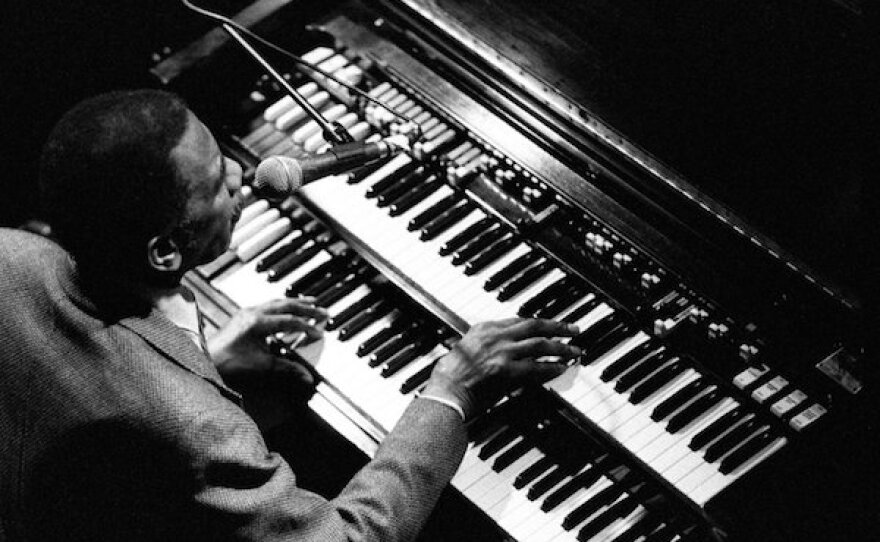Don't be mistaken: Philadelphia is complimented far and wide. The City of Brotherly Love is our well-known handle, and our fine-eating places are the talk of other towns. Also peculiar to the area are those gastronomic delights known as hoagies, soft pretzels, and cheese steaks. We've got Billy Penn; we've got the Liberty Bell.
And don't forget that toward the third quarter of the previous century, Philadelphia became "The Jazz Organ Capital of the World." A good number of jazz organists who became internationally known hailed from here, and were in the vanguard of the jazz organ craze.
Norristown’s Jimmy Smith was the leader. He was originally a pianist, a member of singer/drummer Don Gardner’s Sonotones. But Smith was drawn to the organ in the early 1950s after hearing “Wild Bill” Davis play. He purchased a Hammond B-3 organ—the model of choice by just about all jazz organists—and began to familiarize himself with the complex instrument. He studied its tone wheels, drawbars, two 61-note keyboards, bass pedals, and its many other intricacies.
Jimmy Smith admired Charlie Parker, and wanted to bring the progressive influences to jazz organ that Parker had brought to the alto sax.
Smith preferred playing the organ because it never went out of tune. He admired Charlie Parker, and wanted to bring the progressive influences to jazz organ that Parker had brought to the alto sax. He succeeded gloriously. Those who adopted the instrument after hearing Smith—and there were many, from Philly and well beyond—wanted to play at least half as well.
Philadelphia jazz organists usually coaxed their own unique sound from the B-3, and some went on to carve out excellent careers. Jimmy McGriff, a former Philly police officer, turned in his badge after a couple years. He studied for a time under Jimmy Smith, and ultimately fronted his own groups. McGriff signed with top record labels, traveled extensively, and over the years produced a lengthy discography.
Charles Earland was a very popular organist from here who started on saxophone. It was as a member of McGriff’s band that he became interested in the organ. Earland was a magician on the instrument, switching genres of music around and fusing them at will. He was known as “The Mighty Burner” because he always kept the flame high during his live gigs and recordings.
From North Philly, “Queen of the Organ” Shirley Scott was a dear friend of mine. Saxophonist Eddie “Lockjaw” Davis heard her play at the old Spider Kelly’s jazz spot in Center City, and didn’t have to persuade her to accompany him to New York City, where they would help Count Basie open a nightclub. They remained the featured attraction for several years. Scott married saxophonist Stanley Turrentine in 1960, and they toured and recorded together for the next 10 years.
Trudy Pitts was a classically-trained pianist who played piano in church. Drummer/bandleader Bill Carney was looking for a replacement for his departing pianist, Shirley Scott. He asked Trudy to be his organist, and later his wife: she said yes to both. Although she didn’t play the organ, she was a quick study, and in no time she was playing like she’d invented it. Trudy had no peer when it came to mixing genres of music: She could start out playing “Stolen Moments” and along the way ease in classical, gospel, or blues. Trudy and Bill Carney (a.k.a. Mr. C) often performed together. Her career spanned fifty-plus years, and, like Shirley Scott, she taught music in college.
Trudy Pitts and Mr. C “Steppin’ in Minor” in 2010:
http://youtu.be/iRJ_wbyziN4
Bill Doggett was another Philadelphian who started out on piano and switched to organ. Doggett had international credentials because he was a member of Louis Jordan’s very popular band, and had recorded with Ella Fitzgerald. In 1956 he co-wrote the hit jump tune “Honky Tonk,” which quickly became his signature tune and an R&B standard. He replaced Jimmy Smith in Don Gardner’s trio.
There were many other jazz organ greats who played here during the instrument’s days in the sun, and a few were Richard “Groove” Holmes, Don Patterson, Dan Fogel, and “Papa John” DeFrancesco—whose son, Joey, is today perhaps the number one jazz organist in the world.
But even prior to Philadelphia being known as The Jazz Organ Capital of the World, it had its share of jazz organists who were not as well known outside of the city. Doc Bagby was one; he was the first music director at the storied Uptown Theater. And there was Herb Nix, who held forth at Gert’s Lounge on South Street, just west of Broad. I never met, but heard a lot of talk back in the day about, a fellow named Michel, who played at Catherine’s Postal Card, a very popular South Philly watering hole. “Michel and his Hammond organ” was his calling card.
Howard Whaley was an excellent jazz organist. I was once the emcee at a jazz club where Whaley often played. The club had a broken-down organ that Whaley would have to get in working order before playing. He never failed!
Let me add a bow to the city's small bars that once featured jazz, the ones along old Columbia (now Cecil B. Moore) Avenue, Ridge Avenue, and in other neighborhoods during the jazz organ heyday. Bar owners looking for more bang for their buck always included the hiring of an organist, saxophonist, and drummer in their budget, knowing that they could make a small room rock, and bring in the patrons.
In this thumbnail sketch of the jazz organ and some of the Philadelphians who have played it, I could have included other names. Maybe one day there will be a complete account of not only the jazz organ, but a full story of Philly jazz in general!





